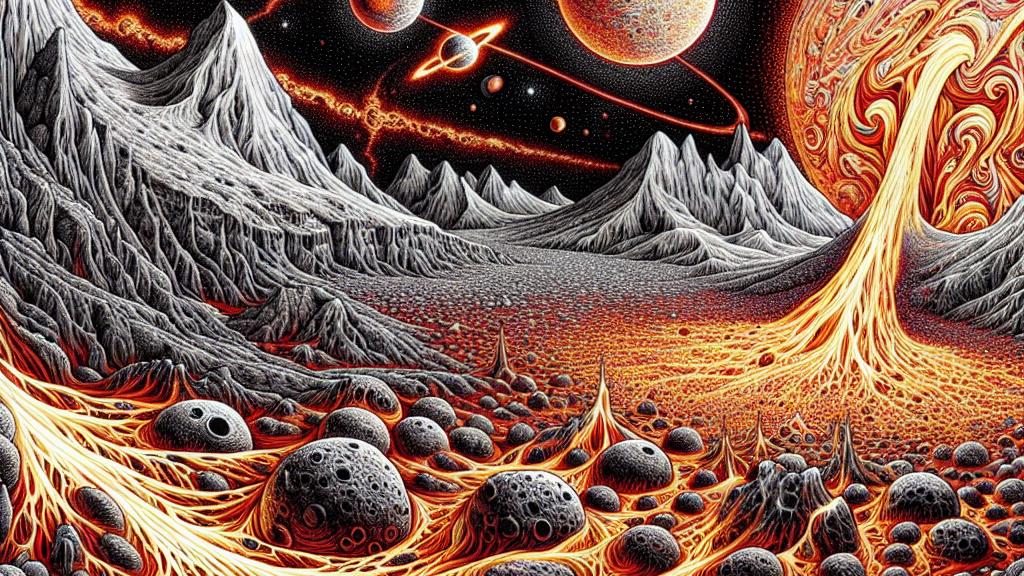Understanding Io's Tidal Forces and Their Impact on Its Volcanoes
Overview
- Io, a dazzling moon orbiting Jupiter, is the most volcanically active body in our Solar System, driven by intense tidal heating.
- Groundbreaking discoveries from NASA's Juno spacecraft reveal that Io possesses a predominantly solid mantle, debunking earlier theories of a shallow magma ocean.
- The intricate dance of tidal forces not only shapes the distribution of volcanoes on Io but also influences their explosive activity.

The Unique Environment of Io
In the vast expanse of the Solar System, where silence reigns supreme, Io bursts forth as a vibrant and tumultuous world. Imagine a landscape teeming with over 400 active volcanoes, each one painting the moon’s surface in fiery reds and yellows. This extraordinary activity is attributed to tidal heating—a fascinating byproduct of the immense gravitational pull exerted by Jupiter. As Io wobbles in its eccentric orbit, it undergoes relentless stretching and compressing, generating staggering amounts of internal heat that turn solid rock into molten lava. Such a hostile yet dynamic environment makes Io a prime subject for scientists who are eager to unravel the mysteries of planetary evolution.
Findings from Juno's Observations
Recent revelations from NASA's Juno spacecraft have taken the world of planetary science by storm. Through meticulous observations, scientists have concluded that Io's tidal response contradicts previous notions of a shallow magma ocean beneath its crust. Instead, Juno's data supports the existence of a solid mantle lurking beneath the surface. This finding upends long-held assumptions about the moon and showcases how rapid melt ascent and localized magma intrusions drive its dramatic volcanic eruptions. For instance, one case study observed a significant eruption that produced a plume reaching over 150 kilometers high—a vivid testament to the moon’s fiery nature. These revelations illuminate the complexity of celestial bodies and emphasize that our understanding of the cosmos is continuously evolving.
Deployment of Advanced Technology
At the forefront of these groundbreaking discoveries is Juno's advanced instrument, the Jovian Infrared Auroral Mapper (JIRAM). This remarkable tool enables scientists to detect thermal emissions in infrared wavelengths, allowing for unparalleled insights into Io's volcanic activity. During its close encounters, Juno captured stunning images that map the distribution of volcanic hot spots across the moon's surface. For example, researchers identified 266 individual hot spots, highlighting how tidal heating patterns influence volcanic output. The varying intensities of heat flow, illustrated vividly in heat maps generated from Juno's observations, provide compelling evidence of how tidal forces actively shape Io's landscape. Such technology not only enhances our understanding but also captures the imagination about what lies beyond our world.
Implications for Astrobiology
While Io may appear stark and desolate, its extreme volcanic activity offers intriguing implications for the field of astrobiology. The exploration of tidal heating in this hellish environment may hold the key to understanding potential life-sustaining conditions on other icy moons like Europa and Ganymede. In fact, the adaptability seen in extremophiles—organisms that thrive in Earth’s most hostile environments—could offer insights into how life might survive under icy shells or in subterranean oceans. By illuminating the effects of tidal forces on such harsh landscapes, Io serves as a fascinating model in our quest to discover life beyond Earth, suggesting that even in the most extreme conditions, life may find a way. Thus, this moon not only captivates scientists but also fuels our curiosity about the unexplored corners of the universe.

Loading...